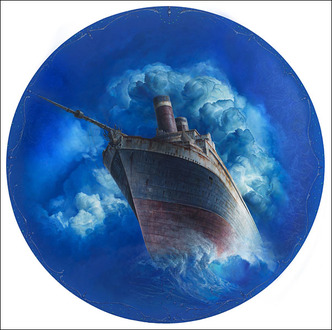 SS Narwhal
SS Narwhal “With these stricken liners I hope to distill all I know of my species and the delicate and fallible systems that sustain us down to a gentle yet startling beauty. I have commissioned these liners as a metaphor for the earth and human activity to create a permanent human record of us,” she says. “These rusting, listing yet still beautiful vessels were filled with every luxury yet finite in resources adrift in an inhospitable cosmos bordered with beauty. They act upon the viewer like a Chaplin film or an opera. On one hand they're lovely and heroic, on the other doomed and sorrowful, each emotion enhancing the other.”
There is something sinister in the reality of the modern ocean liner: they pollute, they are homes to conspicuous consumption and throw away culture. But McGinnis’ liners are of a bygone, more genteel era but an era where all the excesses were still present. In the doomed beauty of these ships McGinnis wants us to find that metaphor of the earth but also something else—a visual caution.
“I hope they serve as beautiful warnings to us all, speaking visually about humanity, triumph, and tragedy and how these conditions co-exist.” says McGinnis.
McGinnis’ family history also comes into play. Her ancestors, from Norway, built luxury yachts for European aristocracy until the advent of steel hull construction.
“The 20th century luxury liner represents a benchmark of technology, human arrogance and great aesthetic attention. I also draw upon the sweetness and delicate imagery of fine china or souvenir collector plates that commemorated the launching of these great vessels,” she says. “The image of impending disaster and human suffering is bounded by the security and beauty of the embracing border imagery that contains everything from kelp and roses to opals and all manner of sea creatures. One MUST get very close to these in the gallery to see the most important content.”
McGinnis’ work is also inspired by Caspar David Friedrich and his work “Sea of Ice.” It is her hope to “bridge the era of great paint handling with that of post modern expectation.”
“In order to record human tendencies as an art form I must be able to observe our species with a schooled mind.” she says.
Her work is, indeed, a record of humanity and its relation to the rest of the natural world. They are more than aesthetically beautiful—they are a profound commentary on human beings, our impermanence and our often deleterious effect on the natural world.
“The exhibition resembles a row of portholes, each a microcosm of its own drama and beauty” says McGinnis. “One may wonder whether they are somewhere within a ship looking out or passing the vessel looking in.”
Her work is not all decaying ocean liners and dilapidated terrestrial structures. Some pieces use unconventional items—lemon rinds or condoms
“My works are always an attempt to stimulate and activate the intellectual overdrive I feel we all possess. My earlier work such as International Lemons Aid reminds us human hardship brought about by overpopulation,” says McGinnis. “The dried lemons are painted every color of human skin tone representing a female role in global family planning. Halved lemons were also an ancient form of birth control [highly acidic cervical cap] the found pearls fill in the gaps between the gold condoms and gold leafed diaphragms. It all celebrates being mindful of our resources and the choices we make as a species.”
The SS Narwhal and The Asphyxiation of the USS Princess are showing at Art Miami.
“The USS Princess is the first in this series. I painted a great decaying luxury liner crashing through dangerous seas with part of her lower bow missing. Surrounding her in a carefully painted border of splashy water shapes are opals, pearls and aquamarine stones,” she says. “The opals are water trapped in mineral and of course these ships are mineral trapped in water. As the splashy shapes travel around the border they drop into one of the Princess' funnels, symbolizing her eminent demise though a beautiful one.”
Both paintings are oil on birch board on panel.
“The NARWHAL has scarring on her hull, as a whale has on its body. Every bolt and rivet is visible and the mast has fallen forward with twisted rigging suggesting the long twisted tusk of the Narwhal whale. The bow figure is a female pelvis [another fragile vessel that human life depends upon], the ribs opening up and becoming wings,” says McGinnis. “The border, a sinewy flourish of blue flow china shapes with vases, more fragile vessels. Surrounding the storm clouds an organic spot varnish. This changes as one moves their eyes across the piece.”















 RSS Feed
RSS Feed